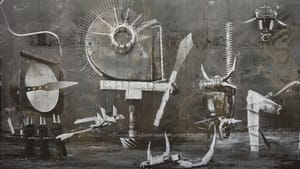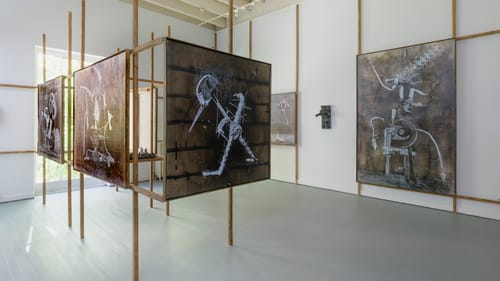Stay in the Loop
BSR publishes on a weekly schedule, with an email newsletter every Wednesday and Thursday morning. There’s no paywall, and subscribing is always free.
Machines dream in a post-worker world
The Print Center presents Rodrigo Valenzuela: Workforce

Raised in Santiago, Chile, during Augusto Pinochet’s dictatorship and its aftermath, Rodrigo Valenzuela creates photographs of surreal environments that position humanity against industrial exploitation, censorship, and repression. Workforce includes a range of Valenzuela’s stunning and mysterious artworks.
Many of the artist’s images are strange scenes starring constructions built from scavenged machine parts and other detritus, which he then photographs in staged settings. Valenzuela distorts time and space: the pictures could be from the 1930s, a dystopian future, or another planet. Humans are present in only six of the works in the show, while most of the pieces are inhabited by weird mechanical entities. The absence of people is unsettling, yet the scenes are fascinating.
Fantastical machines
Workforce is Valenzuela’s first exhibition in Philadelphia, co-curated by independent curator Liz K. Sheehan and Liz F. Spungen, executive director of the Print Center; the show includes a site-specific installation, videos, prints, ceramics, and mixed-media works on canvas. On the first floor, large gelatin silver prints from Valenzuela’s series Afterwork (2021) transport viewers to unfathomable places. The black-and-white photographs convey post-apocalyptic factory scenes on a grand scale—or do they? A wondering gaze reveals barely recognizable elements in Valenzuela’s fantastical machines: nails, washing machine drums, umbrella skeletons.
The artist’s constructions are beautiful and bizarrely inviting, and each photograph is harmonious. Steam or smoke wafts around the floors or spews from tubes. The machines’ functions are impossible to name; sometimes they look animated, gesturing to the viewer and one another. The lustrous Afterwork prints look as if they should be measured in brush strokes rather than pixels.
Troubling struggles
Valenzuela was inspired to use art for social change in reaction to the censorship and violent repression of the Pinochet regime and, after receiving a bachelor’s degree in art history and photography, he emigrated from Chile. In the US, he worked as a day laborer while earning a bachelor’s degree in philosophy and a master’s degree in photo/media. His experience as an immigrant is a major influence on his artwork, which has won international acclaim, including a Guggenheim Fellowship, a Joan Mitchell Award, and prestigious residencies.

In the second-floor galleries, four inkjet prints from Valenzuela’s Devil’s Union (2021) series look very much like paintings. The works show two masked figures interacting and working with tools in a small room, but what they are doing is anybody’s guess. In the darkened back gallery, two videos in muted tones play on a continuous loop, their titles referring to George Orwell’s 1949 novel Nineteen Eighty-four. Prole (2015), situated in a loft-like industrial setting, focuses on workers talking about unionizing. Are some of them arguing against their own interests? Perhaps. Valenzuela shows, but he doesn’t tell. The Unwaged (2017) is silent: roughly six minutes’ contemplation of young people filmed against a dark background. The camera slowly swoops among them as they strive to maintain their balance against what seems to be a strong wind. To watch these people struggling in a precarious setting, with no context at all, is troubling.
Elegant, hostile, resplendent
In the street-facing gallery, Valenzuela’s installation is a minimalist construction site: a spare wood structure in the middle of the room, with more planks around the gallery walls. Works from his Weapons (2022) and Airstrip (2020) series are hung on the structure and walls. Architectural-looking sculptures in hard-fired black clay, the Airstrip artworks (titled in reference to Orwell’s 1984) are elegant and vaguely hostile.
The mixed-media Weapons pieces, more than any other artworks in the exhibition, reveal some of Valenzuela’s labor-intensive creative methods. Menacing constructions with a few recognizable parts (screws, box-cutter blades, lengths of pipe) appear to have been photographed; the prints graffitied and stamped with “strike” and “union;” then screen-printed across hundreds of employee timecards. The large finished pieces are austere, resplendent.
Valenzuela’s Workforce is a pleasure to contemplate, while bringing up critical questions about privilege, agency, the politics of work, and the nature of photography.
What, When, Where
Rodrigo Valenzuela: Workforce. Through July 15, 2023, at the Print Center, 1614 Latimer Street, Philadelphia. (215) 735-6090 or printcenter.org.
Accessibility
There is a small step at the Print Center’s entrance, leading to the first-floor gallery and gallery store. The videos, Devil’s Union, Weapons, and Airstrip artworks are on the second floor, which is only accessible by stairs. For more information, call (215) 735-6090.
Sign up for our newsletter
All of the week's new articles, all in one place. Sign up for the free weekly BSR newsletters, and don't miss a conversation.
 Emily Schilling
Emily Schilling